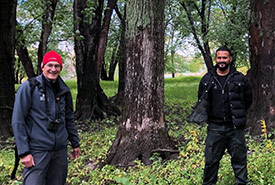
Joël Bonin and Dax Dasilva (Photo by NCC)
Age of Union: A new and crucial partner for the St. Lawrence River
By Joël Bonin, biologist and associate vice-president, Development and Communications for NCC in Quebec
Nature has a way of showing us what is important. In September 2020, tech leader and founder of Age of Union, Dax Dasilva, and I found ourselves on an odyssey down the St. Lawrence River, journeying through ecosystems as unique as you and me. We began in the archipelago located at the head of Lake St. Pierre. We were only an hour’s drive east of Montreal, but it was as if we were in a new world.
Gentle giants and Jurassic-like creatures
There are more than 100 islands in the St. Lawrence River, some untouched by human hands. Century-old trees rise majestically overhead, their bark marked by past spring flood waters. These gentle giants have adapted to survive extreme flooding. Yet, at the same time, from their solid trunks to the tips of their tallest branches, they continue to teem with wildlife. Perhaps it’s a sign of hope.
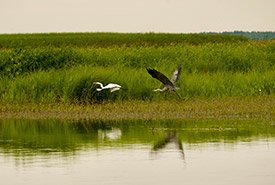
Herons, St. Lawrence River, QC (Photo by Age of Union/Emma Dora Silverstone-Segal)
Great blue herons are everywhere, standing statuesque along the shore waiting for prey, or in flight gliding just in front of our boat. With their blue-grey hue, pointed beak and thin neck, long legs and wide wings, they are one of Canada’s largest and most spectacular wading bird species. The largest roosting colony of herons was founded here, in North America, several centuries ago, as it fished alongside Indigenous Peoples. The first European settlers who came here 400 years ago described these magnificent winged creatures as almost Jurassic-like. Our world has changed drastically since then, but the herons and the flood marks on the trees continue as gentle reminders that, in some ways, river life hasn’t changed much.
Past, present and future considerations
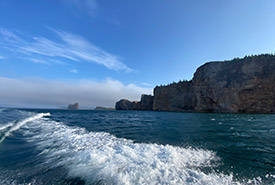
St. Lawrence River, QC (Photo by Age of Union/Emma Dora Silverstone-Segal)
Flooding has been extreme during the last decade, breaking century-old records. I wonder if people will remember these events 100 years from now, and if they will also study the water marks on the trees. Dax and I reflected on this as our boat threaded through the small channels of the vast prairie of emerging wild rice and vegetation in the shallow waters just off the islands. Scientists and biologists call these wetlands the kidneys of the St. Lawrence, filtering water as it flows downstream.
Nearly 20 per cent of the world’s fresh water flows through the St. Lawrence River into the Estuary, where fresh water and salt water meet, eventually emptying into the Gulf of St. Lawrence that opens to the Atlantic Ocean. It takes 300 years for a drop of water to go from the source of the Great Lakes to the ocean. Scientists know that we must take care of our waters so they can continue their vital function. Thankfully, the Age of Union is helping to protect wetlands, islands and shorelines in the St. Lawrence River in order for these habitats to continue playing their role in buffering floods, filtering our drinking water and sustaining fish and other wildlife.
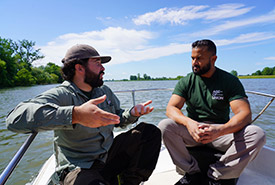
Dax Dasilva and Brian Wilson (Photo by Age of Union/Emma Dora Silverstone-Segal)
Climate change is global and accelerating. Fortunately, many people — like Dax — appreciate the delicate balance of life, and how each of us can make a difference. The Nature Conservancy Canada (NCC), supported by Age of Union and thousands of concerned individuals, is undertaking important restoration work along the St. Lawrence River — cleaning areas, reforesting flood plains and opening channels for spawning fish.
Just for a moment, think about how water intersects with your daily life. You might sip your morning tea or coffee, wash dishes or water your plants. It likely came from these same waterways that Dax and I travelled on. I agree with Dax, that we can all be leaders in caring for nature, and I urge you to look at nature as an enduring partnership. I have seen first-hand the power of people: landowners who work with NCC to conserve land, farmers who opt for practices that give back to the land they till, and people like you and me who volunteer to plant trees and clean up our waterways.
Through awareness efforts, Age of Union is putting front-and-centre the part we all play in caring for nature. Together, we can make it our daily commitment to care for nature. Just fixing a dripping tap or taking a shorter shower in the morning can help. I hope you, too, get the opportunity to experience this beautiful river for yourself and see with your own eyes why it deserves our deepest respect and our enduring care.
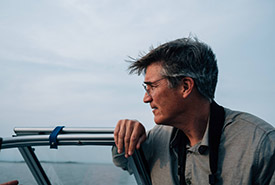
Joël Bonin (Photo by Age of Union/Oli Jobin)
We Are the Saint Lawrence River
During the past year, Age of Union has produced a short film featuring Dax Dasilva, Joël Bonin, as well as more NCC biologists and local environmental voices. Watch the film to learn why protecting our majestic river is crucial for the environment and for our well-being!
The Nature Conservancy of Canada’s mission of protecting natural habitats is undertaken in partnership with Canadians: from landowners to individuals, and from corporations to communities. Over the last 50 years, along with local stakeholders, NCC has acquired and protected the largest single collection of properties on the St. Lawrence River. Thanks to the support of the Age of Union, we are protecting and restoring more habitats that will benefit people and wildlife for generations to come. To get out into nature and help, check out NCC’s Conservation Volunteers program.




